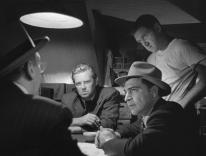Even if you’ve never hung around actors, you’ve probably known somebody like George Reeves, the star of the early 1950s Superman TV show, whose ambiguous suicide (ambiguous enough for some to have called it murder) is the subject of Allen Coulter’s film, Hollywoodland. His type of masculinity achieved its apotheosis, its style and look, right after World War II and flourished until the mid-1960s. (The fashion ads in the Esquire magazine of that period provide the most perfect illustration of the type.) Back then, a young man in an Arrow shirt and a well-cut suit might cultivate his looks and demeanor to suggest a couple of centuries of shrewd Anglo-Saxon interbreeding. An Ivy League education helped, not so much to improve the mind as to perfect a scintillatingly careless manner, not to mention the social networking possible. After graduation, if there wasn’t a family business to enter, the looks and manner of such a youth might help him to secure a toehold in some firm, and no one could begrudge him that, for his easeful smile, his self-effacing wit, his patient curiosity about what you had to say, his gracious willingness to pick your brain, and his sincere admiration that you had a brain worthy of picking, all invited you (at least for the few minutes you conversed with him) to share his purview of a rich and glamorous world that could be conquered only by those who didn’t sweat. The George Reeves type was the East Coast WASP beau ideal (perfected in literature by, of course, an Irish Catholic, Scott Fitzgerald, because literary work is, after all, pretty sweaty).
Though this type flourished on the American stage, it never quite caught on in movies. When you think of the truly great male stars of the entire sound era-the wolfish Bogart, the ferocious Cagney, the lanky Westerners from Gary Cooper to Robert Redford, the Black Irishmen Clark Gable and Tyrone Power, the magnetic louts Nicholson, Brando, De Niro, Pacino-you realize how little use Hollywood generally had for the gentlemanly WASP, unless he came from England, like Cary Grant, or seemed as tweedy as an Englishman, like Melvyn Douglas. It was as if a business founded by immigrants was having its revenge on the class that ruled almost all the other American professions. George Reeves starred only in the then-despised medium of TV, and after Superman was canceled, he had, apparently, nowhere else to go but down. Reeves’s character, or lack of it, may have been fate, but so was the changing complexion of Hollywood stardom. Brando in his torn T-shirt had made it plain that there would be no more Hollywood gentlemen.
In Hollywoodland, Ben Affleck-I pinch myself as I write this to make sure I’m not trapped in a dream-gives a great, yes, a great performance as Reeves. And this isn’t a case of merely casting the appropriate face so that not much acting is needed. It’s a genuine creation accomplished through shrewd observation and dainty craftsmanship: the overly modulated voice, the posture that was made for expensive dinner jackets, the ingratiating smile in the handsome face that is just beginning to go slack, the manner that sets people at ease while clueing the audience that Reeves himself will never be at ease. The Gatsby-like charisma and air of doom that Affleck brings to the role bestow some stature on a pretty boy in decline, and add a touch of tragedy to tabloid fodder.
Affleck’s performance is rooted in well-written scenes by Paul Bernbaum that capture the desperation of the actor as his career slips away and his love affair with Toni Mannix, the wife of a tough MGM studio manager, turns sour. Diane Lane, who has lately made a specialty of sympathetic adulteresses, is at her obsessive best as Toni, while the great Bob Hoskins seizes his single chance, near the conclusion, to turn the seemingly brutish Eddie Mannix into a figure of surprising tenderness without sacrificing an iota of the man’s fearsomeness.
That’s the good news about Hollywoodland; now for the bad. This fascinating study in spiritual decay has a fictional frame story. Gumshoe Louis Simo (Adrien Brody) struggles to uncover the facts of the actor’s decline at the behest of Reeves’s mother, who suspects murder. This framing device might have worked if Simo had been kept as functional and faceless as the shadowy reporter in Citizen Kane, thus allowing the bulk of the movie to be dominated by Reeves. Alas, Brody is the top-billed star and his scenes outnumber Affleck’s. Brody isn’t bad (though if Peter Falk has recently lost his voice, he ought to be informed that Brody has stolen it); it’s just that Simo isn’t an interesting character. The script keeps positing a parallel between Simo and Reeves (both men have difficulty in loving) but it never clicks into place. Simo is a feckless loser who never knows what he wants, while Reeves knows exactly what he wants (stardom). He goes after it fairly ruthlessly but soon discovers that he was born in the wrong era and without sufficient talent to overcome that untimeliness.
The script may be uneven but Allen Coulter’s direction and Jonathan Freeman’s photography give it visual coherence. Coulter, new to the big screen but having several HBO credits, knows how to give his actors juicy opportunities and character-revealing close-ups, while Freeman’s camera serves up the endless mild summer of Californian light.
Despite all the private-eye clichés that Bernbaum loads onto the last third of his script (a “stay-off-the-case!” beating; Simo’s gorgeous, smart girl Friday), the question of whether Reeves’s death was murder or suicide never becomes a proper whodunit. And why should it? The greatness of Affleck’s performance conveys quite early on all the proof we need about what kind of doom awaited George Reeves.
The Black Dahlia deals with another real-life Hollywood mystery, this one definitely unsolved: the mutilation and murder of the beautiful starlet, Elizabeth Short. In Josh Friedman’s adaptation of James Ellroy’s novel, a young police detective played by Josh Hartnett solves the case and dispatches the killer, but for various reasons conceals the truth.
Brian De Palma directed and Vilmos Zsigmond photographed. Each shot revels in operatic garishness and proclaims its virtuosity. Dirty L.A. streets and alleys look like settings from an MGM 1950s musical. If Scarlett Johansson stands in front of a stucco wall to chat with a lover, we gasp at the way the whiteness of the wall harmonizes with her light blue sweater. When the hero enters a lesbian night club to gather information, its floor show is a Sapphic extravaganza worthy of an invert Busby Berkeley. The result of all these visual pyrotechnics is a story that never gets clearly told.
Was this De Palma’s intention? Maybe, for in truth Friedman’s screenplay has no focus. (This can’t be true of the novel, unread by me, for Ellroy is a solid craftsman.) Themes are broached only to be casually dropped with scarcely any examination. Just as the movie’s signature tune keeps trying to turn into the musical theme from Chinatown, the entire film keeps trying to turn into, first, Chinatown (political corruption leads to murder), then Laura (a detective obsessed with a dead beauty), then L.A. Confidential (the solidarity of police partners threatened by femme fatales), and finally-believe it or not-The Addams Family (a household of grotesques provides the solution). Was Friedman creating a series of homages to his favorite films? Or did De Palma mess with the storyline for the sake of shot-by-shot virtuosity? And is the campiness of the entire second half-a campiness that puts the kiss of death to any audience involvement with the mystery-a reversion by the director to his youthful efforts, Greetings and Hi, Mom counterculture, National Lampoon-type entertainments? If so, he picked the wrong script with which to stroll down memory lane.
The actresses are better than the male leads (Hartnett is too soft for his role while Aaron Eckhart hams his up). As the femmes fatales, Hilary Swank and Johansson glitter, and in the title role Mia Kirshner is immensely touching, her performance crying out for a better vehicle than The Black Dahlia, which is a confusing and self-indulgent dud.
Please email comments to [email protected] and join the conversation on our Facebook page.
Previous Story
Uncomfortably Beautiful
Next Story
Unjust & Indefensible


